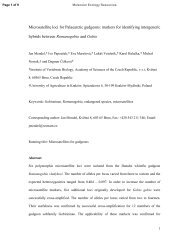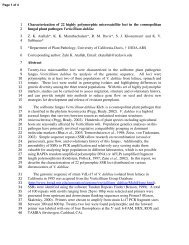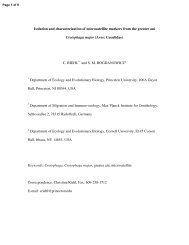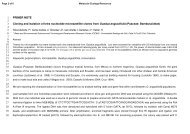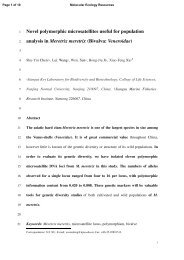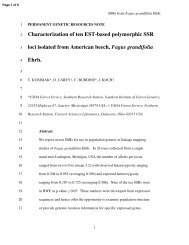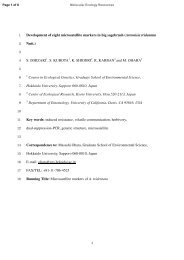(Photololigo) chinensis - Molecular Ecology Resources Primer ...
(Photololigo) chinensis - Molecular Ecology Resources Primer ...
(Photololigo) chinensis - Molecular Ecology Resources Primer ...
You also want an ePaper? Increase the reach of your titles
YUMPU automatically turns print PDFs into web optimized ePapers that Google loves.
Page 1 of 9<br />
1<br />
2<br />
Isolation and characterization of highly polymorphic microsatellites in the mitre squid,<br />
Uroteuthis (<strong>Photololigo</strong>) <strong>chinensis</strong><br />
3<br />
4<br />
Y. W. Sin a, b, 1 , K. H. Chu a , Cynthia Yau b<br />
5<br />
6<br />
a Simon F. S. Li Marine Science Laboratory, Department of Biology, The Chinese University<br />
of Hong Kong, Shatin, Hong Kong<br />
7<br />
8<br />
b Swire Institute of Marine Science, Division of <strong>Ecology</strong> & Biodiversity, School of Biological<br />
Sciences, The University of Hong Kong, Pokfulam Road, Hong Kong<br />
9<br />
10<br />
11<br />
Keywords: cephalopod, cross-species, enrichment, primer, SSR, Uroteuthis (<strong>Photololigo</strong>)<br />
edulis<br />
12<br />
Running title: Microsatellite markers in U. (P.) <strong>chinensis</strong><br />
13<br />
14<br />
Corresponding author:<br />
15<br />
Cynthia Yau; fax: +852 22990606; E-mail address: cynthia-yau@hkucc.hku.hk<br />
16<br />
17<br />
18<br />
Correspondence address: Swire Institute of Marine Science, Division of <strong>Ecology</strong> &<br />
Biodiversity, School of Biological Sciences, The University of Hong Kong, Pokfulam Road,<br />
Hong Kong<br />
19<br />
20<br />
21<br />
1 Present address: Department of Zoology, University of Oxford, Oxford, OX1 3PS,<br />
United Kingdom.<br />
1
Page 2 of 9<br />
22<br />
Abstract<br />
23<br />
24<br />
25<br />
26<br />
27<br />
28<br />
29<br />
30<br />
The mitre squid, Uroteuthis (<strong>Photololigo</strong>) <strong>chinensis</strong>, is a commercially important species in<br />
many coastal regions of Asia. Little information is available on their population structure and<br />
mating system. We developed 12 polymorphic microsatellite markers using enrichment<br />
protocol. The number of alleles per locus ranged from 5 to 27, and levels of expected<br />
heterozygosity ranged between 0.70 and 0.97. These loci should prove useful for population<br />
and parentage studies. Cross-species amplifications of 21 microsatellite loci developed for<br />
Loligo vulgaris and Loligo forbesi in U. (P.) <strong>chinensis</strong>, and of all 33 microsatellite loci in two<br />
other commercially important Uroteuthis species were not successful except for one locus.<br />
2
Page 3 of 9<br />
31<br />
Body of the manuscript<br />
32<br />
33<br />
34<br />
35<br />
36<br />
37<br />
38<br />
39<br />
40<br />
41<br />
42<br />
43<br />
44<br />
45<br />
Microsatellite DNA markers were firstly applied in population genetic studies of cephalopods<br />
in 1999 (Shaw et al., 1999), and their use has increased in recent years (Shaw, 2002). For<br />
example, they were used to determine whether seasonal and/or geographical groups represent<br />
distinct populations in a number of loliginid squids and cuttlefishes (Garoia et al., 2004;<br />
Reichow and Smith, 2001; Shaw et al., 2004). Uroteuthis (<strong>Photololigo</strong>) <strong>chinensis</strong> supports a<br />
very important commercial fishery in mainland China and Taiwan on the continental shelf off<br />
Guangdong, southern Fujian and around the Pescadore Islands in the Taiwan Strait (Voss and<br />
Williamson, 1971). It accounts for up to 90% of the loliginid catch in several parts of China.<br />
It also accounts for 15-40% of the trawl catch in the Gulf of Thailand. Uroteuthis<br />
(<strong>Photololigo</strong>) <strong>chinensis</strong> is also caught in north Australian waters and it is believed to occur in<br />
small quantities in Indonesian, Malaysian and Philippine catches (Roper et al., 1984).<br />
However, little is known about the population structure and mating system of this species.<br />
Thus we isolated and characterized 12 polymorphic micorsatellites from U. (P.) <strong>chinensis</strong> in<br />
order to examine its population biology.<br />
46<br />
47<br />
48<br />
49<br />
50<br />
51<br />
52<br />
53<br />
Total DNA was extracted from ethanol-preserved mantle of an U. (P.) <strong>chinensis</strong><br />
individual using the QIAamp DNA Mini Kit (Qiagen, Hilden, Germany). Microsatellites<br />
were isolated following the protocol of Glenn & Schable (2005). Briefly, 2 µg of genomic<br />
DNA was digested with RsaI and fragments were ligated to Super SNX linkers. Biotinylated<br />
probes (mix 2 and mix 4) were used to perform subtractive hybridization. After enrichment, 2<br />
µL of DNA enriched with repeats was amplified using the SuperSNX-24 as primer in a 25-µL<br />
reaction. The resulting PCR products were ligated into pMD18-T vector (Takara) and<br />
transformed into the bacterial host E. coli JM109. Bacteria were ampicillin selected and<br />
3
Page 4 of 9<br />
54<br />
55<br />
56<br />
57<br />
58<br />
59<br />
60<br />
inserts were PCR amplified using M13 forward and M13 reverse primers. The PCR program<br />
consisted of denaturation at 94°C for 3 min followed by 35 cycles of 94°C for 20 s, 50°C for<br />
20 s, 72°C for 1 min. Inserts between 150 bp and 1000 bp were gel purified (Qiagen, Hilden,<br />
Germany), and were sequenced in both direction using M13 forward and M13 reverse primers<br />
(Macrogen). DNA amplification primers were designed from 38 clone sequences displaying<br />
suitable repeat motifs, using the program OLIGO 4.05 (National Bioscience), of which 12<br />
pairs yielding the best results are presented in Table 1.<br />
61<br />
62<br />
63<br />
64<br />
65<br />
66<br />
67<br />
68<br />
69<br />
70<br />
These 12 microsatellites and 21 loci developed for other loliginid squids, Loligo<br />
vulgaris (Guarniero et al., 2003) and Loligo forbesi (Emery et al., 2000; Shaw, 1997), were<br />
characterized in 30 U. (P.) <strong>chinensis</strong> individuals collected in Hong Kong, China. Genomic<br />
DNA was extracted using the QIAamp DNA Mini Kit (Qiagen, Hilden, Germany). Each<br />
PCR consisted of 20 ng DNA, 0.4 µM of each primer, 1xPCR buffer (50 mM KCI, 1.5 mM<br />
MgCl 2 , and 10 mM Tris-HCl), 200 µM dNTPs and 0.5 U Taq DNA polymerase (GE<br />
Healthcare). PCR conditions consisted of a denaturation stage at 94°C for 3 min followed by<br />
34 cycles of 30 s at 94°C, 30 s at the locus-specific annealing temperature (Table 1) and 30 s<br />
at 72°C, followed by 72°C for 3 min. PCR products were scored on 5% denaturing<br />
polyacrylamide gels following electrophoresis.<br />
71<br />
72<br />
73<br />
74<br />
75<br />
76<br />
<strong>Primer</strong> sequences and genetic diversity statistics for the 12 newly developed loci are<br />
presented in Table 1. All primer pairs amplified products of expected size. Expected and<br />
observed heterozygosities, deviations from Hardy-Weinberg expectations (HWE), and linkage<br />
disequilibrium were estimated using GENEPOP version 3.4 (Raymond and Rousset, 1995).<br />
All 12 of the loci screened were polymorphic in U. (P.) <strong>chinensis</strong>. The number of alleles<br />
ranged from five to 27 (Table 1). Expected heterozygosity ranged from 0.70 to 0.97. Nine<br />
4
Page 5 of 9<br />
77<br />
78<br />
79<br />
80<br />
81<br />
82<br />
loci had allele frequencies supporting HWE and three loci significantly deviated from HWE<br />
after Bonferroni correction (Table 1). Using Micro-Checker 2.2.3 (Van-Oosterhout et al.,<br />
2004), we detected the presence of null alleles in these three loci. No pairs of loci<br />
significantly deviated from linkage equilibrium. For the investigation of the crossamplifications<br />
of the 21 loci in U. (P.) <strong>chinensis</strong>, successful amplification and polymorphism<br />
was only found in Lfor3 (Shaw, 1997) (Table 1).<br />
83<br />
84<br />
85<br />
86<br />
87<br />
88<br />
Cross-species amplification was investigated in two other commercially important<br />
Uroteuthis species: Uroteuthis (<strong>Photololigo</strong>) edulis and Uroteuthis (<strong>Photololigo</strong>) duvauceli.<br />
Cross species PCR were run at the optimal conditions identified for U. (P.) <strong>chinensis</strong>, and<br />
products were separated and scored on silver-stained polyacrylamide gels. Polymorphic<br />
amplification was only found in the locus Lfor3 (Table 2), which may represent a<br />
microsatellite common to a wide variety of squids.<br />
89<br />
90<br />
91<br />
This study provides 12 new polymorphic loci that will be valuable in studies of mating<br />
system, genetic diversity, genetic population structure and assessments of gene flow in U. (P.)<br />
<strong>chinensis</strong>.<br />
92<br />
93<br />
Acknowledgments<br />
94<br />
95<br />
This study was fully supported by a grant from the Research Grants Council, Hong Kong<br />
SAR (project no. HKU 7613/05M).<br />
96<br />
97<br />
References<br />
5
Page 6 of 9<br />
98<br />
99<br />
100<br />
101<br />
102<br />
103<br />
104<br />
105<br />
106<br />
107<br />
108<br />
109<br />
110<br />
111<br />
112<br />
113<br />
114<br />
115<br />
116<br />
117<br />
118<br />
119<br />
120<br />
121<br />
122<br />
123<br />
124<br />
125<br />
126<br />
127<br />
128<br />
129<br />
130<br />
131<br />
132<br />
133<br />
134<br />
135<br />
Emery AM, Shaw PW, Greatorex EC, Boyle PR, and Noble LR (2000) New microsatellite<br />
markers for assessment of paternity in the squid Loligo forbesi (Mollusca:<br />
Cephalopoda). <strong>Molecular</strong> <strong>Ecology</strong> 9, 110-111.<br />
Garoia F, Guarniero I, Ramsak A, Ungaro N, Landi M, Piccinetti C, Mannini P, and Tinti F<br />
(2004) Microsatellite DNA variation reveals high gene flow and panmictic<br />
populations in the Adriatic shared stocks of the European squid and cuttlefish<br />
(Cephalopoda). Heredity 93, 166-174.<br />
Glenn TC, and Schable NA (2005) Isolating microsatellite DNA loci. Methods in<br />
Enzymology 395, 202-222.<br />
Guarniero I, Garoia F, Placido RD, Ramsak A, Mannini P, and Tinti F (2003) Speciesspecific<br />
microsatellite loci for the European squid (Loligo vulgaris). <strong>Molecular</strong><br />
<strong>Ecology</strong> Notes 3, 312-313.<br />
Raymond M, and Rousset F (1995) GENEPOP version 1.2: population genetics software<br />
for exact tests and ecumenicism. Journal of Heredity 86, 248-249.<br />
Reichow D, and Smith MJ (2001) Microsatellite reveal high levels of gene flow among<br />
populations of the California squid Loligo opalescens. <strong>Molecular</strong> <strong>Ecology</strong> 10, 1101-<br />
1109.<br />
Roper CFE, Sweeney MJ, and Nauen CE (1984) FAO species catalogue. Vol. 3.<br />
Cephalopods of the world. An annotated and illustrated catalogue of species of<br />
interest to fisheries. FAO Fisheries Synopsis 125, 277 pages.<br />
Shaw PW (1997) Polymorphic microsatellite markers in a cephalopod: the veined squid<br />
Loligo forbesi. <strong>Molecular</strong> <strong>Ecology</strong> 6, 297-298.<br />
Shaw PW (2002) Past, present and future applications of DNA-based markers in<br />
cephalopod biology, workshop report. Bulletin of Marine Science 71, 67-78.<br />
Shaw PW, Arkhipkin AI, Adcock GJ, Burnett WJ, Carvalho GR, Scherbich JN, and Villegas<br />
PA (2004) DNA markers indicate that distinct spawning cohorts and aggregations<br />
of Patagonian squid, Loligo gahi, do not represent genetically discrete<br />
subpopulations. Marine Biology 144, 961-970.<br />
Shaw PW, Pierce GJ, and Boyle PR (1999) Subtle population structuring within a highly<br />
vagile marine invertebrate, tthe veined squid Loligo forbesi, demonstrated with<br />
microsatellite DNA markers. <strong>Molecular</strong> <strong>Ecology</strong> 8, 407-417.<br />
Van Oosterhout C, Hutchinson WF, Wills DPM, and Shipley P (2004) MICRO-CHECKER:<br />
software for identifying and correcting genotyping errors in microsatellite data.<br />
<strong>Molecular</strong> <strong>Ecology</strong> Notes 4, 535-538.<br />
Voss GL, and Williamson GR (1971) Cephalopods of Hong Kong Hong Kong Government<br />
Press, Hong Kong.<br />
6
Page 7 of 9<br />
136<br />
Table 1<br />
Core repeat, primer sequences (5’ to 3’), and optimal annealing temperature<br />
137<br />
138<br />
139<br />
140<br />
141<br />
(T a ) for microsatellite loci isolated from Uroteuthis <strong>chinensis</strong>. n is the number of individuals<br />
successfully genotyped in U. <strong>chinensis</strong>, H O and H E are observed and expected<br />
heterozygosities, respectively. H O significantly different from Hardy-Weinberg expectations<br />
after Bonferroni correction are indicated by asterisks (*). Data are also given at a locus<br />
isolated from Loligo forbesi (Shaw 1997).<br />
Locus Repeat <strong>Primer</strong>s 5’-3’ T a<br />
( o C)<br />
Allele size<br />
range (bp)<br />
GenBank<br />
Accession<br />
no.<br />
n<br />
No. of<br />
alleles<br />
H E<br />
H O<br />
Uchi1<br />
(TATG) 9TATC(TTTC) 2(TATC) 3TT<br />
TC(TATC) 3…(TATC) 10<br />
F: TAAAATGTAACTTCCGAAATACC<br />
R: ACACAAAAGCAAACAGACACAGG<br />
60 187-317 FJ980010 27 25 0.94 0.78<br />
Uchi2 (GA) 3(TAGA) 2CA(GATA) 6(GA) 11<br />
GTGAAC(GA) 2GG(GA) 9<br />
F: GATGACTAATAAGGATGGTTGGA<br />
R: TGAGATCAAAACAGGTTGAACTT<br />
60 225-311 FJ980011 27 26 0.97 0.89<br />
Uchi3 (GAA) 27 F: CTACGATTATACTGGGGAAGGTG<br />
59 215-278 FJ980012 30 18 0.93 0.83<br />
R: TAGTCTAATTTGTCTGTATGGTT<br />
Uchi4 (TGA) 13 F: GATAAGGACGGGTGGGGAGAAAG<br />
59 166-235 FJ980013 30 19 0.94 0.67*<br />
Uchi5<br />
R: TCGTGGAAAGAGATTACTGCAAA<br />
(GT) 4…(GT) 7…(GT) 6…(GT) 4…(G F: ATGGGTCTATTTTGAAGCCTATG<br />
T) 5<br />
R: GACACAAACAGAGAAAGAGAAAT<br />
59 195-201 FJ980014 29 5 0.70 0.38*<br />
Uchi6 (AG) 18AC(AG) 3AC(AG) 2AT(AG) 3<br />
AC(AG) 2AT(AG) 9…(AG) 8<br />
F: ACGGAGTATTTCGTCTGGCAATG<br />
R: ATCTGCTGGATGTCCCCTACTTG<br />
59 229-287 FJ980015 30 24 0.94 0.97<br />
Uchi7 (CAA) 16 F: AAGTATAAGAAATGAAATGAACC<br />
54.3 132-177 FJ980016 30 14 0.89 0.87<br />
R: CATTAAAAGTGAAAGATATTGTC<br />
Uchi8 (GA) 35 F: AACATATTTCTCAGGGGATTTTC<br />
59 122-166 FJ980017 29 20 0.94 0.93<br />
R: TACCTTTCAGTGTCATCGCATAC<br />
Uchi9 (CT) 10…(TC) 12 F: CGAAGTTATTTTCCAAGACATTA<br />
59 233-297 FJ980018 19 15 0.91 0.58*<br />
R: ATTTCTCTGCATTCCTGCTAAGC<br />
Uchi10 (TG) 20 F: GTGTATGTGTGCGTGCGTGGATG<br />
59 259-297 FJ980019 29 20 0.95 0.97<br />
R: TCTCCCTCAGTTGTTGTTTGAAC<br />
Uchi11 (CAT) 10(TCTG) 3(TC) 4 F: TTCTATTTAACCAGGAACGAAAG<br />
54 141-164 FJ980020 25 13 0.86 0.68<br />
R: AATGATGGATAGGGACGGTTGGA<br />
Uchi12 (AC) 15…(AAG) 27 F: TGGGGTCATGGAAACACTCAAAG<br />
59 271-331 FJ980021 30 27 0.96 0.90<br />
R: AAGAGCCGTCAAATTCGAGGATC<br />
7
Page 8 of 9<br />
<strong>Primer</strong>s published for Loligo forbesi<br />
Lfor3 (AAT) 22 F: GGTCATGTCATTCTCTGCAC<br />
60 122-161 27 13 0.92 0.93<br />
R: ACATTTATCCATTAACAGAGTAGCA<br />
8
Page 9 of 9<br />
142<br />
Table 2<br />
Numbers of alleles and size ranges observed for Lfor3 (Shaw 1997) in two<br />
143<br />
Uroteuthis species<br />
U. (P.) edulis U. (P.) duvauceli<br />
Locus n Number<br />
of alleles<br />
Size<br />
range<br />
H E /H O P HW n Number<br />
of alleles<br />
Size<br />
range<br />
H E /H O<br />
P HW<br />
Lfor3 8 12 124-181 0.96/1.00 NS 6 4 124-148 0.80/1.00 NS<br />
144<br />
NS = P > 0.05.<br />
9




